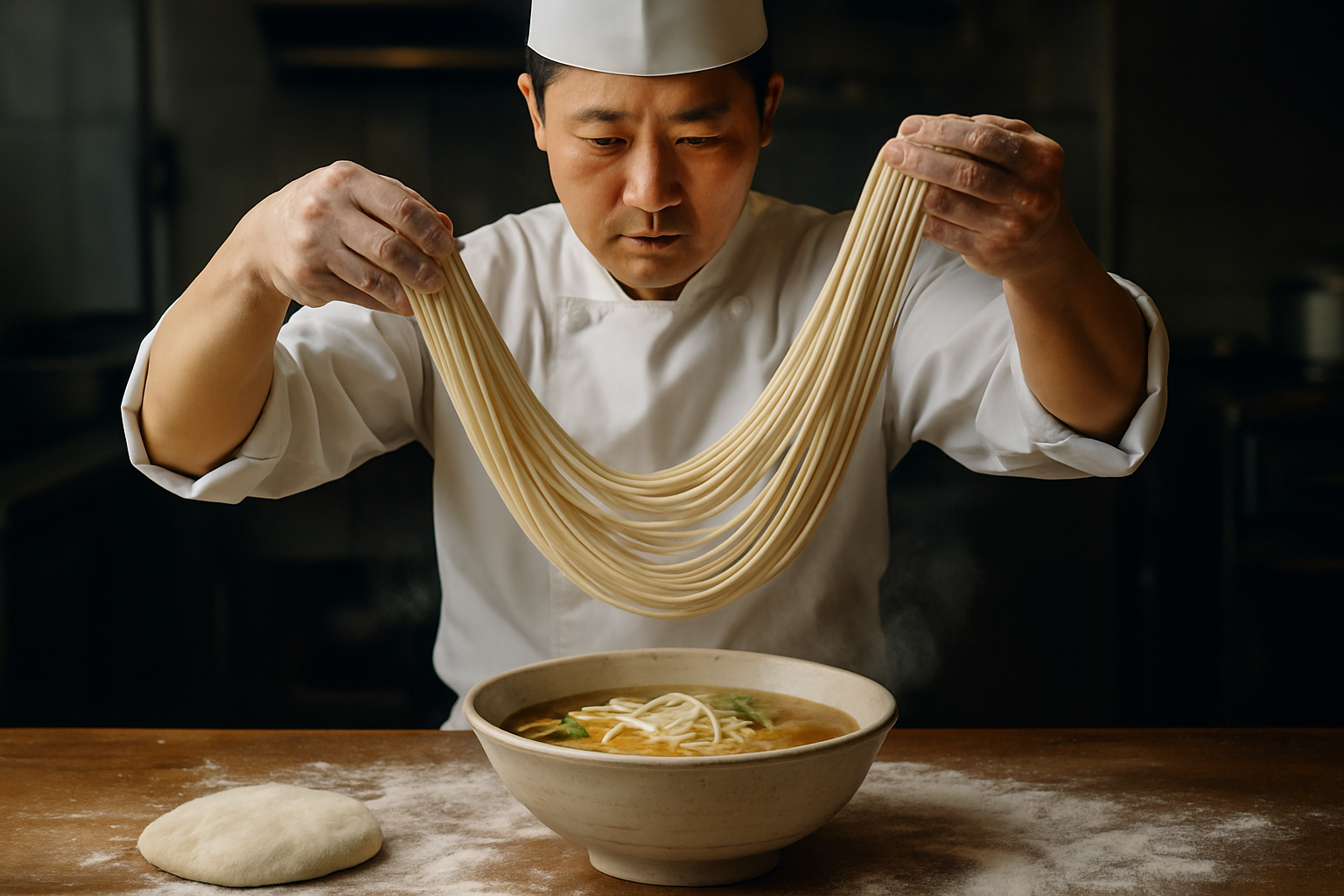Noodle Nirvana: The Art of Hand-Pulled Perfection
Slurp your way into a world of culinary mastery as we explore the mesmerizing craft of hand-pulled noodles. From ancient techniques to modern twists, this time-honored tradition is experiencing a renaissance in kitchens worldwide. Join us on a journey through the elastic, chewy, and utterly delicious realm of artisanal noodle-making.

From Street Stalls to Michelin Stars
Once primarily found in humble street stalls and family-run shops, hand-pulled noodles are now gracing the menus of high-end restaurants and attracting the attention of culinary innovators worldwide. This surge in popularity has led to a fascinating fusion of traditional techniques with modern culinary trends. Chefs are experimenting with unconventional ingredients, incorporating everything from beetroot for vibrant pink noodles to activated charcoal for dramatic black strands. The versatility of hand-pulled noodles allows them to be adapted to various cuisines beyond their Asian roots. From Italian-inspired hand-pulled pasta to Mexican-fusion noodle dishes, the possibilities are endless. This global appreciation has not only elevated the status of noodle-making as a culinary art form but has also sparked a renewed interest in preserving and evolving this ancient craft.
The Science Behind the Stretch
At the heart of hand-pulled noodles lies a fascinating interplay of chemistry and physics. The process begins with a simple dough of flour, water, and salt, but the magic happens in the manipulation. As the dough is worked, the proteins in the flour (primarily glutenin and gliadin) form gluten networks. These networks give the dough its elasticity and allow it to be stretched without breaking. The repeated pulling and folding aligns these gluten strands, creating a structure that results in the characteristic chewy texture of the noodles. Temperature and hydration play crucial roles in this process. Too cold, and the dough becomes stiff and unworkable; too warm, and it becomes sticky and loses its structure. The precise balance of water content is also critical – too dry, and the dough won’t stretch; too wet, and it won’t hold its shape. Understanding these principles allows noodle makers to adjust their techniques for different flour types and environmental conditions, ensuring consistently perfect noodles.
Mastering the Technique: A Journey of Patience
Learning the art of hand-pulled noodles is a journey that requires patience, practice, and perseverance. For beginners, the process can be frustrating as the dough often breaks or becomes uneven. However, with time and practice, one begins to develop a feel for the dough – understanding when it needs more rest, when to apply more pressure, and how to achieve the perfect consistency. The key lies in developing muscle memory and intuition. Experienced noodle makers can tell by touch alone when the dough is ready for pulling. They know exactly how much force to apply and how to manipulate the dough to achieve the desired thickness and texture. This skill is often passed down through generations, with master noodle makers spending years perfecting their craft before passing on their knowledge to apprentices. The learning process is not just about technique but also about developing an appreciation for the ingredients and the cultural significance of the craft.
Beyond the Bowl: Creative Applications
While traditionally served in soups or stir-fries, hand-pulled noodles are finding new and innovative applications in modern cuisine. Innovative chefs are using these noodles as a canvas for culinary creativity, pushing the boundaries of texture and flavor. Some are experimenting with infused doughs, incorporating herbs, spices, or even vegetable purees directly into the noodle base. Others are exploring alternative cooking methods, such as deep-frying hand-pulled noodles to create crunchy noodle nests as garnishes or bases for salads. In the world of molecular gastronomy, chefs are playing with the concept of hand-pulled noodles, creating noodle-like strands from unexpected ingredients using similar stretching techniques. This expansion beyond traditional uses is opening up new possibilities for hand-pulled noodles in fusion cuisines, desserts, and even as artistic elements in plating designs. The versatility of these noodles continues to inspire culinary professionals and home cooks alike to push the boundaries of what’s possible in noodle cuisine.
Noodle Know-How: Tips and Tricks
• Always use high-protein flour for better gluten development and elasticity
• Let the dough rest for at least 30 minutes before pulling to relax the gluten
• Keep your hands and work surface lightly oiled to prevent sticking
• Practice the basic ‘fold and pull’ technique before attempting more complex stretches
• Experiment with different flours like whole wheat or buckwheat for varied flavors and textures
• Cook fresh hand-pulled noodles immediately for the best texture and taste
The art of hand-pulled noodles is a testament to the enduring appeal of traditional culinary crafts in our modern world. As we’ve explored, this technique is not just about creating food; it’s about preserving culture, understanding science, and pushing the boundaries of culinary creativity. Whether you’re slurping a bowl of lamian in a bustling street market or savoring an avant-garde noodle creation in a high-end restaurant, remember that each strand carries with it centuries of tradition and countless hours of practice. The next time you encounter hand-pulled noodles, take a moment to appreciate the skill, dedication, and artistry that goes into every bowl. And who knows? You might be inspired to embark on your own noodle-pulling journey, joining the ranks of culinary artisans keeping this delicious tradition alive and evolving.





